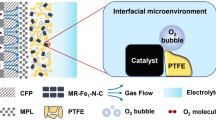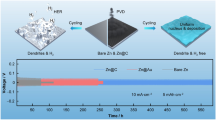Abstract
Zn-air batteries are promising energy storage and conversion systems to replace the conventional lithium-based ones. However, their applications have been greatly hindered by the formation of Zn dendrites and ZnO passivation layer on the Zn anodes. Herein, we report the fabrication of an artificial protective layer comprised of N-doped threedi-mensional hollow porous multi-nanochannel carbon fiber with well-dispersed TiO2 nanoparticles (HMCNF). The incorporated TiO2 nanoparticles and N dopants improve the ion flux distribution and promote the surface adsorption, facilitating the interfacial pseudocapacitive behaviors during Zn deposition. The hierarchical architecture also induces homogenous electric field distribution at the anode/electrolyte interface. Accordingly, the deposition behavior of Zn is regulated, giving rise to enhanced utilization and rechargeability of Zn. When integrated in alkaline Zn-air batteries, the HMCNF-coated Zn anodes exhibit improved electrochemical performances relative to those with the bare Zn anodes, demonstrating a versatile strategy to boost energy storage of metal anodes through optimizing surface adsorption properties.

摘要
目前, 锌-空气电池的商业化应用受限于锌枝晶的生长和氧化锌 钝化层的形成. 本文通过构筑三维多孔多纳米通道碳复合纤维 (HMCNF)作为锌负极人工固体电解质界面层来解决这一问题. 其中, 均匀负载的TiO2纳米颗粒和氮掺杂基团有效改善了锌的分布和吸附过 程, 从而有利于锌沉积过程中界面类电容行为的发生; 同时, 三维多孔 多纳米通道的微观结构也使得电场在电极/电解液界面得以均匀分布. 因此, 锌的沉积溶解过程得到有效调控. 与未添加人工界面层的锌负极 相比, 基于HMCNF界面层的锌负极的碱性锌-空气电池的电化学性能 得到明显提升. 这种基于优化表面吸附来调控金属沉积溶解动力学的 策略也可进一步推广至其他金属负极体系来提高其电化学性能.
Similar content being viewed by others
References
Sun W, Wang F, Zhang B, et al. A rechargeable zinc-air battery based on zinc peroxide chemistry. Science, 2021, 371: 46–51
Peng W, Jin J, Yang S, et al. Hollow Co9S8 spheres-derived polyhedrons uniformly anchored on N, S-doped graphene for efficient oxygen electrocatalysts. Compos Commun, 2021, 23: 100587
Peng W, Yang X, Mao L, et al. ZIF-67-derived Co nanoparticles anchored in N doped hollow carbon nanofibers as bifunctional oxygen electrocatalysts. Chem Eng J, 2021, 407: 127157
Peng W, Wang Y, Yang X, et al. Co9S8 nanoparticles embedded in multiple doped and electrospun hollow carbon nanofibers as bifunctional oxygen electrocatalysts for rechargeable zinc-air battery. Appl Catal B-Environ, 2020, 268: 118437
Zhou T, Zhang N, Wu C, et al. Surface/interface nanoengineering for rechargeable Zn-air batteries. Energy Environ Sci, 2020, 13: 1132–1153
Moni P, Deschamps A, Schumacher D, et al. A new silicon oxycarbide based gas diffusion layer for zinc-air batteries. J Colloid Interface Sci, 2020, 577: 494–502
Lee D, Lee H, Gwon O, et al. Monolithic heteronanomat paper air cathodes toward origami-foldable/rechargeable Zn-air batteries. J Mater Chem A, 2019, 7: 24231–24238
Zhang XG. Secondary batteries-zinc systemsxxxzinc electrodes: Overview. In: Garche J (ed.). Encyclopedia of Electrochemical Power Sources. New York: Elsevier Science, 2009, 454–468
Liang P, Yi J, Liu X, et al. Highly reversible Zn anode enabled by controllable formation of nucleation sites for Zn-based batteries. Adv Funct Mater, 2020, 30: 1908528
Jia H, Wang Z, Tawiah B, et al. Recent advances in zinc anodes for high-performance aqueous Zn-ion batteries. Nano Energy, 2020, 70: 104523
Zheng J, Zhao Q, Tang T, et al. Reversible epitaxial electrodeposition of metals in battery anodes. Science, 2019, 366: 645–648
Fu J, Cano ZP, Park MG, et al. Electrically rechargeable zinc-air batteries: Progress, challenges, and perspectives. Adv Mater, 2017, 29: 1604685
Sasaki Y, Yoshida K, Kawasaki T, et al. In situ electron microscopy analysis of electrochemical Zn deposition onto an electrode. J Power Sources, 2021, 481: 228831
Parker JF, Nelson ES, Wattendorf MD, et al. Retaining the 3D framework of zinc sponge anodes upon deep discharge in Zn-air cells. ACS Appl Mater Interfaces, 2014, 6: 19471–19476
Xu C, Liao J, Yang C, et al. An ultrafast, high capacity and superior longevity Ni/Zn battery constructed on nickel nanowire array film. Nano Energy, 2016, 30: 900–908
Li M, Meng J, Li Q, et al. Finely crafted 3D electrodes for dendrite-free and high-performance flexible fiber-shaped Zn-Co batteries. Adv Funct Mater, 2018, 28: 1802016
Wang X, Wang F, Wang L, et al. An aqueous rechargeable Zn//Co3O4 battery with high energy density and good cycling behavior. Adv Mater, 2016, 28: 4904–4911
Parker JF, Chervin CN, Nelson ES, et al. Wiring zinc in three dimensions re-writes battery performance—dendrite-free cycling. Energy Environ Sci, 2014, 7: 1117–1124
Park DJ, Aremu EO, Ryu KS. Bismuth oxide as an excellent anode additive for inhibiting dendrite formation in zinc-air secondary batteries. Appl Surf Sci, 2018, 456: 507–514
Lee CW, Sathiyanarayanan K, Eom SW, et al. Novel alloys to improve the electrochemical behavior of zinc anodes for zinc/air battery. J Power Sources, 2006, 160: 1436–1441
Lee CW, Sathiyanarayanan K, Eom SW, et al. Effect of additives on the electrochemical behaviour of zinc anodes for zinc/air fuel cells. J Power Sources, 2006, 160: 161–164
Wu Y, Zhang Y, Ma Y, et al. Ion-sieving carbon nanoshells for deeply rechargeable Zn-based aqueous batteries. Adv Energy Mater, 2018, 8: 1802470
Zhu JL, Zhou YH. Effects of ionomer films on secondary alkaline zinc electrodes. J Power Sources, 1998, 73: 266–270
Zhang Y, Wu Y, You W, et al. Deeply rechargeable and hydrogenevolution- suppressing zinc anode in alkaline aqueous electrolyte. Nano Lett, 2020, 20: 4700–4707
Moshtev RV, Zlatilova P. Kinetics of growth of zinc dendrite precursors in zincate solutions. J Appl Electrochem, 1978, 8: 213–222
Fang Y, Zhang SL, Wu ZP, et al. A highly stable lithium metal anode enabled by Ag nanoparticle-embedded nitrogen-doped carbon macroporous fibers. Sci Adv, 2021, 7: eabg3626
Xiao J. How lithium dendrites form in liquid batteries. Science, 2019, 366: 426–427
Rauda IE, Augustyn V, Dunn B, et al. Enhancing pseudocapacitive charge storage in polymer templated mesoporous materials. Acc Chem Res, 2013, 46: 1113–1124
Zhu Y, Meng F, Sun N, et al. Suppressing sponge-like Li deposition via AlN-modified substrate for stable Li metal anode. ACS Appl Mater Interfaces, 2019, 11: 42261–42270
Kresse G, Hafner J. Ab initio molecular-dynamics simulation of the liquid-metal-amorphous-semiconductor transition in germanium. Phys Rev B, 1994, 49: 14251–14269
Kresse G, Furthmüller J. Efficiency of ab-initio total energy calculations for metals and semiconductors using a plane-wave basis set. Comput Mater Sci, 1996, 6: 15–50
Kresse G, Joubert D. From ultrasoft pseudopotentials to the projector augmented-wave method. Phys Rev B, 1999, 59: 1758–1775
Blöchl PE. Projector augmented-wave method. Phys Rev B, 1994, 50: 17953–17979
Perdew JP, Burke K, Ernzerhof M. Generalized gradient approximation made simple. Phys Rev Lett, 1996, 77: 3865–3868
Monkhorst HJ, Pack JD. Special points for Brillouin-zone integrations. Phys Rev B, 1976, 13: 5188–5192
Naseem S, Wu CM, Xu TZ, et al. Oil-water separation of electrospun cellulose triacetate nanofiber membranes modified by electrophoretically deposited TiO2/graphene oxide. Polymers, 2018, 10: 746
Liu W, Yao T, Xie S, et al. Integrating TiO2/SiO2 into electrospun carbon nanofibers towards superior lithium storage performance. Nanomaterials, 2019, 9: 68
Yang Y, Qiu M, Liu L. TiO2 nanorod array@carbon cloth photocatalyst for CO2 reduction. Ceramics Int, 2016, 42: 15081–15086
Zhang JJ, Wei Z, Huang T, et al. Carbon coated TiO2-SiO2 nanocomposites with high grain boundary density as anode materials for lithium-ion batteries. J Mater Chem A, 2013, 1: 7360–7369
Wang H, Huang X, Li W, et al. TiO2 nanoparticle decorated carbon nanofibers for removal of organic dyes. Colloids Surfs A-Physicochem Eng Aspects, 2018, 549: 205–211
Holder CF, Schaak RE. Tutorial on powder X-ray diffraction for characterizing nanoscale materials. ACS Nano, 2019, 13: 7359–7365
Zhang J, Huang T, Yu A. Synergistic effect of amorphous carbon coverage and enlarged voltage window on the superior lithium storage performance of nanostructured mesoporous anatase TiO2: Emphasis on interfacial storage phenomena. J Alloys Compd, 2014, 606: 61–67
Ji L, Zhou S, Liu X, et al. Synthesis of carbon- and nitrogen-doped TiO2/carbon composite fibers by a surface-hydrolyzed PAN fiber and their photocatalytic property. J Mater Sci, 2020, 55: 2471–2481
Zhou T, Shen J, Wang Z, et al. Regulating lithium nucleation and deposition via MOF-derived Co@C-modified carbon cloth for stable Li metal anode. Adv Funct Mater, 2020, 30: 1909159
McKubre MCH, Macdonald DD. The dissolution and passivation of zinc in concentrated aqueous hydroxide. J Electrochem Soc, 1981, 128: 524–530
Deyab MA, Mele G. Polyaniline/Zn-phthalocyanines nanocomposite for protecting zinc electrode in Zn-air battery. J Power Sources, 2019, 443: 227264
Liu M, Yang L, Liu H, et al. Artificial solid-electrolyte interface facilitating dendrite-free zinc metal anodes via nanowetting effect. ACS Appl Mater Interfaces, 2019, 11: 32046–32051
Yuksel R, Buyukcakir O, Seong WK, et al. Metal-organic framework integrated anodes for aqueous zinc-ion batteries. Adv Energy Mater, 2020, 10: 1904215
Lan CJ, Lee CY, Chin TS. Tetra-alkyl ammonium hydroxides as inhibitors of Zn dendrite in Zn-based secondary batteries. Electrochim Acta, 2007, 52: 5407–5416
Lee YS, Kim YJ, Ryu KS. The effects of CuO additives as the dendrite suppression and anti-corrosion of the Zn anode in Zn-air batteries. J Industrial Eng Chem, 2019, 78: 295–302
Lin C, Kim SH, Xu Q, et al. High-voltage asymmetric metal-air batteries based on polymeric single-Zn2+-ion conductor. Matter, 2021, 4: 1287–1304
Zhang J, Huang T, Zhang L, et al. Molybdenum-doped titanium dioxide and its superior lithium storage performance. J Phys Chem C, 2014, 118: 25300–25309
Acknowledgements
This work was supported by the National Natural Science Foundation of China (52002060), Shanghai Sailing Program (20YF1400600), and the Fundamental Research Funds for the Central Universities (2232021D-06).
Author information
Authors and Affiliations
Contributions
Zhang J designed the experiments and carried out the synthesis, characterization and electrochemical tests. Peng W conducted part of the synthetic work. Jin J and Yang S assisted in the preparation of the carbon nanofiber. Zhang J, Yu A and Li G conceived and directed the project, and prepared the manuscript.
Corresponding authors
Additional information
Conflict of interest
The authors declare that they have no conflict of interest.
Supplementary information
Supporting data are available in the online version of the paper.
Jingjing Zhang received her PhD degree from Fudan University in 2015. Then, she worked as a senior research scientist at Bosch (China) Investment Ltd. Now she works as a lecturer at the State Key Laboratory for Modification of Chemical Fibers and Polymer Materials, College of Materials Science and Engineering, Donghua University. Her research interests include metal-air batteries, lithium-ion batteries, and solid state lithium-ion batteries.
Aishui Yu received his PhD degree from Fudan University in 1993. In 1995–2006, he worked at Iwate University (Japan), the Institute of Materials Research and Engineering (Singapore), the University of Oklahoma (USA), and then at the Excellatron Solid State LLC in USA. He rejoined Fudan University as a professor in 2006. His research interests include lithium-air batteries, lithium-ion batteries, solid state lithium-ion batteries and lithium-sulfur batteries.
Guang Li received her PhD degree from Donghua University. She joined Donghua University as a lecturer in 1990, and was promoted to associate professor in 1993 and full professor in 1999. She was a senior visiting scholar at the University of Twente, Netherlands in 1996. Her current research interests include the design and synthesis of functional fiber materials, and their applications in energy-related fields.
Electronic supplementary material
Rights and permissions
About this article
Cite this article
Zhang, J., Peng, W., Jin, J. et al. Artificial solid-electrolyte interface facilitating uniform Zn deposition by promoting chemical adsorption. Sci. China Mater. 65, 663–674 (2022). https://doi.org/10.1007/s40843-021-1778-2
Received:
Accepted:
Published:
Issue Date:
DOI: https://doi.org/10.1007/s40843-021-1778-2




